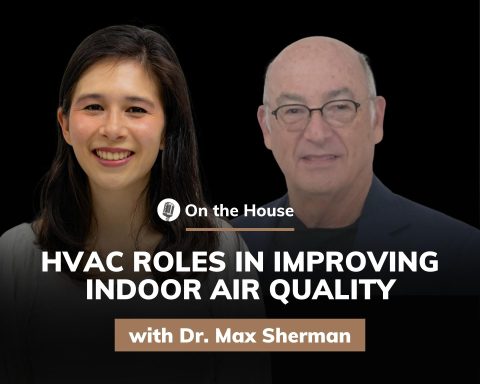Every year, 4.3 million people die as a result of household air pollution, with 60% dying from cardiovascular diseases and 40% dying from pulmonary diseases.
Indoor air pollution can cause a variety of health problems ranging from eye problems to respiratory illnesses and cancer. It can be said that household air pollution is a silent killer because oftentimes, the majority of households do not have the awareness of the activities that contribute to the release of indoor air pollutants. Thus, household members need to understand the concepts of air circulation and misconceptions about indoor air pollution to be able to reduce it.
Why does air circulation matter?
Air circulation is an important element that makes a household function well and can be defined as the movement of air in a room or known as airflow. Air circulation is affected by ventilation systems, cracks, windows, objects, and the movement and activities of individuals within the house, among other things. For example, when a household member is burning wood fire inside the house or cooking that results in a lot of smoke, it will increase indoor air pollution.
Indoor air pollution has a negative impact on low birth weight, stillbirths in pregnant women, asthma and tuberculosis exacerbations, cataracts, and blindness. Poor air quality not only aggravates the symptoms of lung conditions but also contributes to the development of asthma in young children.
Inadequate airflow in the house might worsen the indoor air quality within the house. So, it is important to maintain good air circulation within the house to ensure that the house has good air quality and to ensure the members of the household are healthy.
Misconceptions about indoor air pollution
Did you know that pollution is not only happening outdoors? Many people somewhat believe that this is true. However, it is a misconception because air pollution can happen inside the house too. The source of indoor air pollution mostly comes from activities that were thought to be harmless. These activities include cooking, using air fresheners, and utilizing mosquito repellents.
Cooking
Cooking is done using a variety of heat sources such as gas, wood, and electricity. Each of these heat sources can contribute to indoor air pollution while cooking. The combustion from cooking, especially in low-efficiency home stoves, emits high levels of a variety of air pollutants, resulting in severe air pollution and negative health consequences. Inefficient solid fuel combustion in home stoves contributes to severe indoor air pollution, which accounts for nearly 1.64 million premature deaths worldwide.
Aerosol products
Air fresheners produce a variety of volatile organic compounds, some of which are hazardous air pollutants. A single fragrance in a product can contain hundreds of chemicals, some of which (for example, limonene, a citrus scent) react with ozone in the environment to form dangerous secondary pollutants.
Furthermore, various types of mosquito repellents such as discs, spray, or electric liquid have a high possibility of emitting Volatile Organic Compounds (VOC) in the house. Exposure to chemicals from aerosol products has been linked to a variety of health issues, including headaches, respiratory difficulties, and migraine.
How can we reduce air pollution at home?
Household members could reduce air pollution in the home by improving ventilation inside the house, reducing the usage of some products that emit pollutants, and improving the air inside the house. These are some of the things that can be done to reduce air pollutants in the home:
Open the windows
First, poor air quality can be improved by opening a window and allowing pollutants to dissipate faster. Ventilation is one of the control strategies for sustaining air quality at home. Proper air circulation throughout the house helps maintain the temperature and humidity and prevent particles from building up. Through indoor-outdoor air exchange, ventilation dilutes air pollutants in limited places.
Switch to gas stoves
Second, change the cooking methods from traditional cooking such as using wood fuel to a gas stove. Although a gas stove also emits pollutants, it is better than cooking using solid fuel or traditional methods.
Carbon monoxide (CO) concentration and fine particulate matter (PM2.5) concentration were estimated to be reduced by 30% and 39%, respectively when modern cooking methods were used instead of traditional cooking methods.
However, because a gas stove has the potential to emit pollutants, it is recommended to cook with a cooker hood. Turning on the cooker hood while cooking will reduce the combustion that is caused by cooking activities. However, if the house is not equipped with a cooker hood, it is best to open the window while cooking to improve ventilation.
Avoid spray-based products
Third, stop using spray-based household products because it emits VOCs that are posing a risk to the household members. A study conducted in Melbourne, Australia (2019) found that eliminating the use of air fresheners improves air quality as it reduces secondary pollutant formation and concentrations.
Instead of using dangerous chemicals, try to use natural methods and ingredients such as planting fragrant houseplants, using coffee beans as a natural air freshener, and using baking soda to absorb bad-smelling odors within the house.
Use an air purifier
Lastly, use an air purifier in the house to remove pollutants. Air purifiers, which can both efficiently inactivate germicides and remove pollutants, can be used to improve indoor air quality. Many commercial air purifiers claim to be effective at removing pollutants from the environment, providing clean, pollutant-free air, and thus improving indoor air quality.
In conclusion
There is still a lot of misconception about indoor air quality although it is an important element that makes a household healthy and well-functioning. Implementing practices such as improving ventilation, using a cooker hood, omitting the utilization of aerosol products, and using air purifiers in the house could contribute to reducing indoor air pollutants. Clean indoor air helps household members to be more productive as it makes them feel energized.
If you would like to know more about indoor air circulation, visit the Household Management Science Labs. The lab uses the research of the Institute for Life Management Science to produce courses, certifications, podcast, videos, and other learning materials. Check out the Household Management Science Labs today.
Photo by Jill Burrow on Pexels




